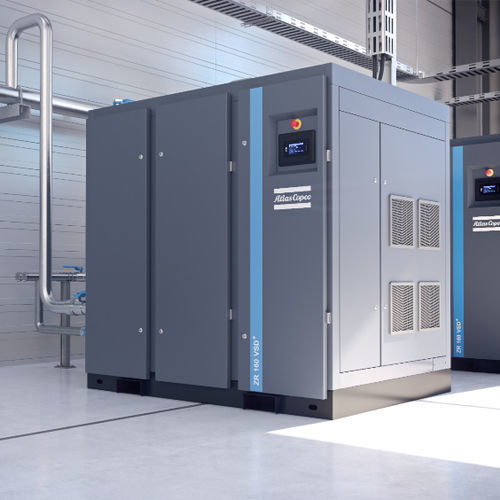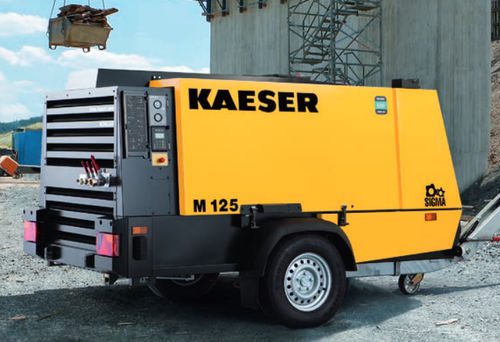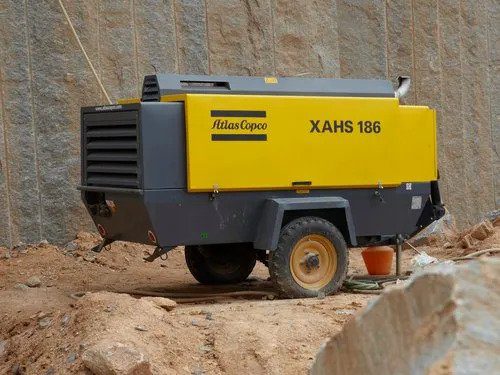With so many models adapting to current needs and technology, it’s easy to get overwhelmed when choosing between diesel, electric, and hybrid-engine equipment. However, looking at the engine’s capabilities, and some of its use cases, is a great place to start.


or rent an electric or diesel mobile air compressor:
- Initial cost relative to application
- Safety and movement
- Service
- Efficiency and autonomy
- Noise and emissions
1. Initial cost relative to application
Although diesel engines have increased in price by as much as 25 per cent over the past five
years their technology and performance has also improved dramatically. While it is generally
accepted that an electric-powered equivalent costs less to buy, this advantage is irrelevant if a
power supply isn’t available on site.
For instance, an infrastructure improvement project located in an urban area will probably
feature an establish power source. However, a new construction site that is remotely located
will more than likely not have access to grid electricity.
To further aid the argument for diesel-driven air compressors many are now available with
a built-in generator. Clearly this is not possible with an electric unit that, depending on location,
will require a generator to power it. With this in mind, it suggests a diesel driven option is a more
versatile solution for new work sites in remote locations. That said many large sites install a
generator as standard practice, so there is often a much simpler decision to make when an electric powered compressor can just plug into it.
Satisfied With The Facilities At Relco (EA) Ltd Rental Services.
Mark J. Zamberg
2. Safety and movement
Electric units are inherently safer. There is no risk of injury from hot parts, such as an exhaust pipe or muffler, and in hazardous environments, there is no need to transport combustible fuel around a job site. Furthermore, environmental issues, such as the outcome of ground contamination from diesel spillage, are avoided.
A physical electric unit might be safer overall, but on the other hand, diesel machines do not need to be plugged in like their electric counterparts – where electric cables positioned around a site can pose a potential trip hazard if not managed efficiently. It is also important to ensure that cabling is of the right quality to eliminate any possibility of insulation stripping and exposure to a live main.
Electric-powered machines are generally smaller in size as there is no need for a fuel tank, radiator, or intercooler. However, in the case of like-for-like models, the running weight would be similar to a diesel equivalent as electric motors are relatively heavy. What’s more, diesel-driven compressors have no cables to unplug and clear when the machine needs to be moved.
In the past, electric machines were not really focused on movement across the site. They were more suited for ‘drop and run’ type applications. However, current models of both types invariably offer the same movability features, such as wheels, lifting hooks, and forklift slots.
3. Service
Because electric units don’t feature any removable engine parts, service intervals can be extended by a factor of four. Routine maintenance on the motor is a simple procedure and just requires changing the grease.
Conversely, over the lifetime of a diesel unit maintenance costs have typically been in the region of a minimum of €1.00 an hour. However, this has begun to decrease as manufacturers have striven to make maintenance procedures much simpler and quicker to complete. For instance, with the latest types of diesel-driven compressors it’s now possible to realise service intervals from 250 hours up to 1000 hours, or once every two years.
Establishing the total cost of ownership is an essential calculation within the purchase decision process that needs to include the prospect of residual values. The diesel-powered air compressor market comprises very well-established used equipment businesses and a large portion of the residual value of a diesel unit applies to the engine. Conversely, mobile electric air compressors are not so well proven and established within the second-hand market. For this reason, due consideration of this factor within operational budgets is important.
4. Efficiency and autonomy
Let’s begin by looking at a typical example. A 250 (7 cubic m3/min) CFM electric compressor that’s connected to the grid will typically consume 38 KWh of electricity, which, at a rate of 0.25 € per KWh, equates to a cost of 9.5 euros per hour. Meanwhile, an equivalent diesel machine, operating in Europe, will typically consume 13.2 litres per hour of fuel, which, at a rate of 1 euro a litre, equates to a cost of 13.2 euros per hour.
Clearly then, one of the biggest variables when comparing the two technologies is the ever-shifting price of diesel and electricity, which differs greatly region-by-region and can dramatically affect the cost model outlined above. It should also be noted that if an electric compressor is running from an on-site diesel generator, and not the grid, the diesel consumption would be on a comparable level to just using a diesel air compressor.
Something that also needs to be taken into account is how the fuel efficiency of both diesel and electric compressors can differ greatly between manufacturers. For instance, a diesel compressor featuring an efficient Tier 4 engine, optimized with the integration of an advanced air end, will consume fuel at a much lower rate than one that has not been in-house designed to work together in the same way. It’s also worth keeping in mind that, as a general rule, the bigger a diesel-driven engine gets the more efficient it becomes. They obviously consume more fuel than smaller engines and savings can, therefore, be higher, depending on the electrical costs and optimized performance of the diesel engine.
There is no doubt that if fuel prices continue to rise that the arguments for using electric machines will increase in the coming years. Although the cost of running electrical units varies depending on the size of the motor, this outlay is likely to come down as new high-efficiency models are being launched to cover larger power ratings. Furthermore, electric machines typically have a clear advantage over diesel equivalents in the case of compressors powered by Tier 2 or 3 engines, which are primarily used in countries where the regulations are not as strict as in Europe and North America.
5. Noise and emissions
With regard to environmental concerns, electrically-powered compressors have no competition. When it comes to noise, electric machines can be up to five decibels lower than diesel.
There are some claims that electric compressors are emission-free. While that can be considered technically correct to a certain degree, to operate they need to plug into a source of power which itself will generate CO2. This has to be a key consideration as the process of producing compressed air is not the most energy efficient. Choosing an efficient choice will greatly reduce the impact of CO2 in the production of compressed air.
Diesel engines do produce additional nitrogen oxides (NOx) and other pollutants that are linked to a variety of climate change and health issues. For this reason, governments and manufacturers have invested huge resources into cleaning up diesel engines. However, they can never be as clean as electric motors when it comes to greenhouse gas emissions.
Conclusion
There is no right or wrong answer.
Differences between the two technologies are dependent mainly on availability of power and energy costs. In both cases, the running costs of an electric motor or Tier 4 diesel engine will differ greatly between manufacturers – this should always be looked at in-depth before purchasing and should never be assumed that all are roughly the same.
Electric portable machines are gaining traction in the four large emerging markets and developing countries of Brazil, Russia, India, and China (BRIC) due to improvements in power infrastructure, relatively low electricity costs and the fact that the compressors has a lower initial purchase price. However, diesel remains largely the power of choice in most of Europe, North America, Middle East and Africa due to the ‘stand-alone’ nature of the power source
and the performance of the latest regulated diesel engines.
Looking to the future the compressed air sector has to meet the same challenges as many other industries with a switch towards cleaner energy sources. The advancements in electric power solutions, battery technology and renewable energy will, for sure, play a bit part in the future. It’s true that electric, typically, will usually offer gains in efficiency and lower running costs. However,
do check the points made in this article and don’t take it for granted that diesel is not the best choice for the end application, because, today, it might just be the case.


